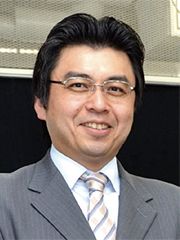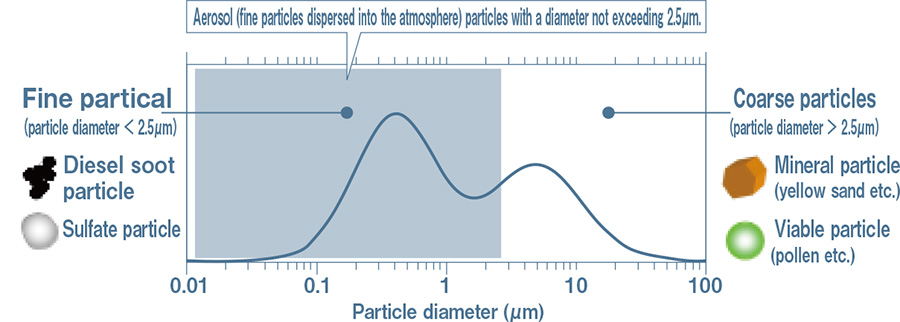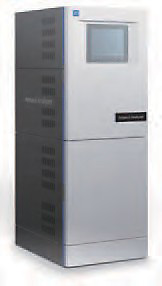Research Results
Developing combined analysis system equipment for airborne minute substances
Contributing investigation of the actual conditions of PM 2.5 FY2016

- Nobuyuki Takegawa (Professor at the Department of Chemistry, Graduate School of Science and Engineering, Tokyo Metropolitan University)
- Development of Advanced Measurement and Analysis Systems
"System development: Development of an Online Aerosol Particle Combined Analysis System" team leader (2008-2012)
Particles, bringing about grave effects on health and climate, due to their small size, without allowing themselves to be observed.
M2.5 has been drawing attention as a causative agent of air pollution. PM2.5 is the general term for microscopic particulate matter (aerosol particles) with a diameter not exceeding 2.5 micrometers. It is considered that aerosol particles, due to their small size, are likely to become deposited in bronchi and lungs, thus constituting a major factor in respiratory disease. In addition, there is concern over their impact on weather change resulting from their causing sunlight to scatter and becoming nuclei for the generation of cloud as well as their serving as carriers of radioactive material. Since PM2.5 is composed of a wide variety of chemical substances, the reality is that an analytical method to elucidate the actual conditions of PM2.5 has yet to be established.
An aerosol combined analysis system to efficiently collect and analyze such complex PM 2.5 particles was developed. It was Professor Nobuyuki Takegawa (an assistant professor at the Research Center for Advanced Science and Technology of the University of Tokyo at the time development) who served as the team leader.
Typical particle size distribution of aerosol (mass concentration)

Not only their small size but also"variability"stands in the way of research progress
When Professor Takegawa started the research on aerosol, he was troubled with the "instability" of aerosol as well as its small size. Gas components contained in exhaust from factories or vehicles change into particles of nitrate, sulfate or organic substances due to chemical reactions. Such secondary particles constitute a large portion of aerosol. The way chemical reaction happens changes constantly depending on weather conditions and other factors.
Therefore, to understand the actual conditions of aerosol, it is necessary to measure its chemical composition in real time. However, since the concentration of aerosol particles in the atmosphere is very small, it is necessary to employ a special collecting and analyzing method. Professor Takegawa tried using the U.S.-made real-time analysis equipment, but there was a big problem in the efficiency of collecting particles.
With that, Professor Takegawa determined to construct observational equipment of his own. After forming a team with Fuji Electric Co., Ltd., which established an organized coordination with the Research Center for Advanced Science and Technology, and the Japan Agency for Marine-Earth Science and Technology (JAMSTEC), the research was adopted as part of the Development of Advanced Measurement and Analysis Systems. And finally, full-scale development of the observational equipment started.
Real-time analysis made possible by a"particle trap" with a three-dimensional lattice structure
How could small aerosol particles be caught in their entirety in a short period of time? Professor Takegawa and his fellow researchers went through a long process of trial and error in order to find a solution to that biggest challenge, and finally arrived at a"particle trap."
To analyze particles using the conventional method, they have to be vaporized by bouncing them off a heated plate. However, many of the particles don't rebound in a vaporized state. They came up with an idea of using a "lattice"as a trap for catching particles in their entirety. Lattices are placed diagonally to a particle beam like blocking out sunshine with a window blind. Only one lattice is not enough, five are needed. A microscopic and regularly structured three-dimensional lattice actualized by the processing technology of Fuji Electric succeeded in capturing particles with an efficiency of nearly 100%. Thus, it became possible to collect aerosol wholly in a short time.
Finally, an aerosol combined analysis system was completed. This analyzer is equipped with an instrument for"laser-induced fluorescence detection (LIF),"in which biological particles and soil particles are detected as well as an instrument for"laser-induced incandescence detection (LII),"in which particles derived from diesel engine exhaust are detected, in addition to an instrument for "mass spectrometry (MS)," in which chemical composition of sulfate, nitrate, etc. are quantitatively analyzed. Thus, by combining various element technologies effectively, a new analysis method was established, with which a new analysis, which previously could not be performed only by a single method, became possible.
Particle trap in the mass spectrometer

New multiple analysis techniques that should be shared among countries
The completed combined aerosol analysis system was immediately used for trial observations, thus the real- time monitoring of change in the concentration of PM2.5 constituents was brought to realization. Through the monitoring, the importance of measuring the components of fine particle was reconfirmed. For example, an extreme increase in PM2.5 concentration can cause reduced visibility; however, such a phenomenon is not always caused by harmful substances. Reduced visibility can be potentially caused by natural phenomenon such as dust. In the past, it was impossible to identify particles in real time, which now can be performed by using an analysis method in which multiple analysis methods are combined. It is expected that accumulating observational data and thereby advancing the research will lead to the establishment of reliable environmental standards, resulting in ensuring the safety and security of the people.
To that end, much more extensive observation has to be conducted over a larger region. Aerosol easily spreads beyond national boundaries. To understand its behavior precisely, it is necessary to conduct observations not only in Japan, but also in many other parts of the world. The combined aerosol analysis system is commercialized by Fuji Electric in 2015 after the verification test in Kawasaki-shi and other places. In future, it is expected that observational data will be accumulated. Aerosol is considered to be associated with global climate change as well as with air pollution. It is urgent to establish an international strategy with an eye on both widespread air pollution and climate change.

Commercialized Aerosol Particle Combined Analysis System
